
-
Sold
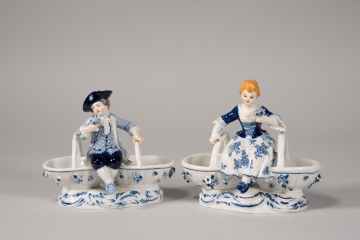
Pair of spice jars. Glazed porcelain. Meissen, Germany, possibly second half of the 19th century. Trademarks and inscriptions on bases. A pair of glazed porcelain spice jars, each with a base featuring a Rococo-inspired wave relief, supporting two baskets with handles and raised floral motifs on the exterior. A figure sits between the baskets: a young man wearing a hat, a young woman holding a bouquet of flowers, both displaying 18th-century influence in their clothing. The predominance of white and blue is reminiscent of the first Chinese porcelains to arrive in Europe on a large scale, works that inspired numerous European factories. Inside the baskets are flowers reminiscent of the well-known Meissen "onion pattern," but in a much simplified form. The Meissen marks (two crossed swords in blue) that appear on the bases of both figures are those used by the factory between 1815 and 1924. On the male figure, additional incised numbers (1320 and 73047) and 2521 in blue ink are also visible. On the female figure, more inscribed numbers (136k, 73035) and 1 in blue ink can be seen.
· Size: 14,5x8x12,5 cms
ANTIQUES
MISCELLANEUS;CERAMIC
Ref.: ZF1464
-
Pair of forged iron fork locks. 17th century. Pair of forged iron fasteners of the so-called “fork” type due to their shape. This type of piece was used in furniture to secure tables, both dining tables and desks, and for this reason it is a very common piece of forged iron. The spirals and the balustrade parts date both to the Baroque period.
· Size: 93x30 cms.
ANTIQUES
MISCELLANEUS;OTHER OBJECTS
Ref.: Z5447
-
Silver naveta. Spain, 17th century. A forged vessel with the base and lid finials obtained by mould casting. Shaped like a symmetrical boat, it stands on a low circular base with a disc-shaped base and a short shaft with a central lens. The body is decorated by chiselling, with oval cartouches flanked by braces and crowned by rhombuses and half-moons, located on the four axes and on a dotted shaded background that extends outlining the mouth. The lid has the same chiseled motif. At the stern end there is a finial in the form of an acanthus leaf, in relief, and at the bow end there is a handle in the form of a banded pillar. The bow lid is openable thanks to a central hinge. The piece has partial punch marks on the lid and body.
· Size: 18,5x9x8,5 cms.
ANTIQUES
MISCELLANEUS;SILVER
Ref.: ZF1253
-
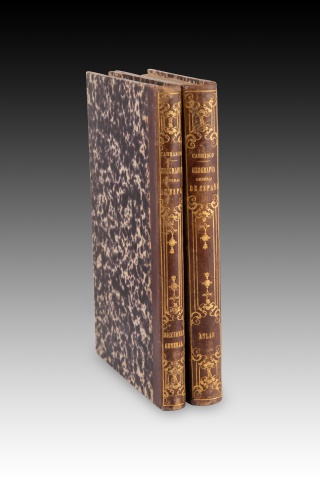
Two volumes: Geographical Atlas of Spain (…) and General Dictionary of all Peoples. Editors Gaspar y Roig. Spain, Madrid, 1864 and 1862. Two volumes framed in a similar way, with leather spines and gold elements. Here a reference to each work (lower area) and the name Carrasco (upper part) appear clearly. One of the volumes is the Geographical Atlas of Spain. Adjacent Islands and Spanish Overseas Possessions. It is indicated that it belongs to the “Collection of maps engraved in steel constructed by Don Martín Ferreiro”, and that it was published in Madrid by the Printing and Bookshop of Gaspar y Roig (the editors), in 1864. It presents a series of maps, engraved in steel (see the touches of color), constructed by Martín Ferreiro and Peralta (1830-1896) and engraved by R. Alabern (indicated under the images). The other volume is the General Geography of Spain. General dictionary of all peoples., belonging to the so-called Illustrated Library of Gaspar and Roig. Published in Madrid, by the Printing and Bookshop of Gaspar and Roig (editors), in 1862.
· Size: 18x5x27 cms.
ANTIQUES
MISCELLANEUS;OTHER OBJECTS
Ref.: ZF1298
-
Vase. Glass. Following models by Émile Gallé (Nancy, 1846-1904). Vase made of glass, with white, brown and gold tones, following both in technique and decoration the well-known Art Nouveau works of Émille Gallé, an artist internationally recognized both for his aesthetics and for his technical advances with glass ("enamel", "cameo", etc.).
· Size: 15x15x28 cms.
ANTIQUES
MISCELLANEUS;CERAMIC
Ref.: Z5671
-
Special Offer! - Off
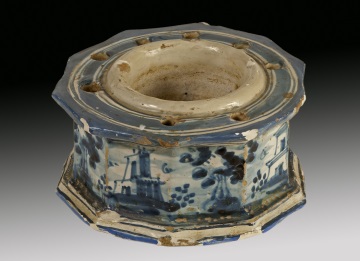
Talavera inkwell, 18th century. Glazed ceramic. Talavera ceramic inkwell, decorated with cobalt blue glaze on a white tin slip With restorations
· Size: 16x16x7 cms.
ANTIQUES
MISCELLANEUS;CERAMIC
Ref.: Z5695
-
Devotional pendant in gold and enamel, Mary Magdalene and Saint John the Baptist, 18th century. Possibly Mallorcan. One of the windows is broken. Oval pendant decorated around its edges with turned gold bows and small metallic pearls. One of its fronts shows Mary Magdalene, as a hermit, with a skull, a cross and a book; the other presents the image of Saint John the Baptist, accompanied by a cross and a lamb, alluding to the Gospel text. These types of pieces were highly valued by their owners as elements of devotion, and could also, at the same time, contain a relic inside.
· Size: 4.5x0,5x4 cms.
ANTIQUES
MISCELLANEUS;OTHER OBJECTS
Ref.: Z6451
-
Candlestick with chain. Silver. Francesc. P. Arquer, Barcelona, Spain, circa 1825. With hallmarks, engraving and ownership marks (AS). Silver candlestick in its colour with an openwork bowl on two levels and raised on two small legs (inside which there is a vase-shaped piece to hold the candle and a braided decoration towards the centre), and a flat handle (curved towards the end, area where the third leg is located), decorated with a series of simple openwork shapes and fine strings of small pearls on the edges of the handle and the bowl. The piece has some engraving marks, others of ownership under the bowl (AS) and others of hallmark. The latter link the piece with Barcelona silverwork, placing it in the workshop of Francesc Arquer, and in the 19th century. Weight: 183 grams.
· Size: 28,9,5x5,5 cms.
ANTIQUES
MISCELLANEUS;SILVER
Ref.: Z6733
-
Special Offer! - Off
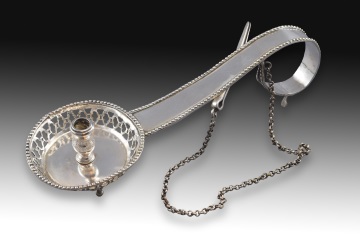
Candlestick with chain and clips. Silver. F. Roca, Barcelona, circa first half of the 19th century. With contrast and engraving marks. A silver candlestick in its natural color, with an openwork bowl raised on two small legs (inside is a vase-shaped piece for holding the candle), and a flat handle (curved towards the end, where the third leg is located), decorated with two bands of pearls on the sides (a motif that also appears on the rim of the bowl). From the end of the handle emerges a small chain that terminates in tongs (which are attached to a piece soldered to the lower part of the handle). The piece bears two engraving marks and hallmarks beneath the bowl. These latter marks indicate that the piece was made in Barcelona by F. Roca, a silversmith active in the city during the second half of the 18th and the beginning of the 19th centuries. Weight: 185 grams.
· Size: 23,5 x 8,5 x 7 cms.
ANTIQUES
MISCELLANEUS;SILVER
Ref.: Z6734
-
Sold
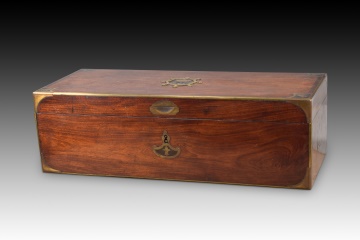
Box or casket with a royal monogram. Mahogany wood, metal. Spain, 19th century. It has slight damage. Rectangular box with a flat lid and a keyhole on the front decorated with metal appliqués on the corners, edges, handles, etc. A fleur-de-lis is featured beneath the keyhole. The lid features a central motif with fleur-de-lis and a crowned M, and alternating crowned castles and lions in the corners. This emblem (and the fact that it is accompanied by lions and castles, alluding to Castilian heraldry) is reminiscent of the royal monograms that, apparently, all members of the royal family had in the past to mark their belongings. In this case, it is possible that it refers to Maria Cristina of Bourbon-Two Sicilies (Palermo, 1806-Sainte-Adresse, 1878), wife of Ferdinand VII and regent during the minority of Isabella II. However, we must remember Maria Cristina of Habsburg-Lorraine or of Austria (1858-1929), wife of Alfonso XII. The emblem of Maria de las Mercedes de Orleans y Borbón (Madrid, 1860-1878), wife of Alfonso XII, usually appeared with two capital "Ms".
· Size: 78x31x24 cms.
ANTIQUES
MISCELLANEUS;OTHER OBJECTS
Ref.: ZF1170
-
18th century ponderal weight. Bronze. Incomplete bronze ponderal, with the container vessel and two of the smaller ones, all cold decorated with incised and stamped motifs, simple edges on the small vessels and more complex borders on the container vessel. Nested cup weights are a set of cup-shaped weights that fit precisely inside each other. A complete set is one that retains all its original cups. The largest, called the keeper, consists of an upper lid with a handle and a closure, and weighs exactly the same as the sum of all the others. The second in descending order weighs half as much as the keeper, and the same as the sum of the rest. This proportionality is maintained until the last weight, called the disk or last piece, which is usually solid and closes the set. This principle remained unchanged until the introduction of the decimal metric system.
· Size: 11x12x12 cms.
ANTIQUES
MISCELLANEUS;OTHER OBJECTS
Ref.: Z3034
-
Special Offer! - Off
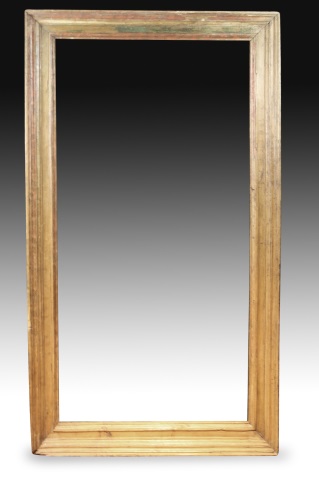
Frame. Carved wood. 17th century. It has faults. Rectangular frame made of carved wood that still retains some of its original polychromy. As was common in several European schools since the Renaissance (particularly the Italian, but also the Spanish, for example), it is decorated with a series of smooth moldings of varying widths, arranged to leave a plain band.
· Size: Ext 175x95 cm Int: 1.55x74 cms.
ANTIQUES
MISCELLANEUS;FRAMES
Ref.: Z6224
-
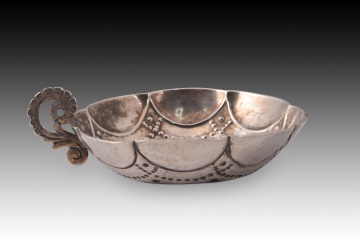
Quaking glass or wine-tasting glass. Silver. 18th century. One handle is missing. A vessel known as a catavinos or tembladera (as it has no foot) made of silver in its colour with a flat handle curved in the shape of an “S” decorated with simplified plant elements, and a line of mortise-shaped pieces (gallon-shaped shapes) on the edge enhanced by a smooth band. Towards the inside it has strings of pearls and dots, and a cross on the bottom. Bernegales and mortise-shaped pieces were frequent in Spanish silverware in the 17th century, usually being relegated to centres of somewhat less importance in the 18th century. Compare with pieces such as the silver bernegal from the last third of the 17th century in the Lázaro Galdiano Museum (perhaps from the Portuguese school; inventory 3916), or the one dated between 1640 and 1665 from the same museum (inventory 3910), or the one by José Jiménez de Illescas (inventory 3915, dated 1715-1725) in the same institution. Weight: 101 grams.
· Size: 12x10x4 cms.
ANTIQUES
MISCELLANEUS;SILVER
Ref.: ZE367
-
Silver spice rack. Stefano Olivero, Italy. Possibly 19th century. Silver spice rack raised on simple legs, located at the chamfered ends of the piece, decorated on the outside with garlands and other architectural elements of classicist influence in light relief. Weight: 198 grams.
· Size: 5,5 x 8,5 x 6,5 cm
ANTIQUES
MISCELLANEUS;SILVER
Ref.: ZF0006
-
Peace-bearer. Bronze. 16th century. Bronze peace-holder with an asymmetrical “S” handle on the back, which features a slightly raised decoration on the front framed in an architectural composition decorated with elements of classical influence (a scallop shell at the top, plant elements in the upper area, columns with decorated shafts, architrave, base with semicircular arches, etc.), which has a heraldic shield in the centre of the lower area. Under a winged angel's head, the central theme of the peace-holder is presented: Lamentation over the body of the dead Christ, with the cross in the background, Mary with Christ, flanked by two figures. The heraldic shield is very similar to that of the House of Mendoza used by Íñigo López de Mendoza y de la Vega, 1st Marquis of Santillana, and progenitor and head of the Ducal House of Infantado (which also features it).
· Size: 7,5x4x12 cms.
ANTIQUES
MISCELLANEUS;OTHER OBJECTS
Ref.: ZF0541A
-
Table clock. Bronze. 1990s, modeled after August Moreau. In working order. Table clock with a raised base and gilt-bronze legs following 19th-century models and a white dial with Roman numerals for the hours. It is topped with a bronze child figure modeled after Auguste Moureau (1834-1917), a French sculptor especially known for his delicate and naturalistic works, part of the Art Nouveau movement, a style of which he was a leading exponent. He made busts, figures, and small sculptures, and his designs were later adopted by many other bronze sculptors due to the artist's success and the quality of his pieces. Weight: 22 kg.
· Size: 35X22,5X64 cms
ANTIQUES
MISCELLANEUS;CLOCKS
Ref.: ZF1410
-
Pair of door knockers. Wrought iron. 16th century. Pair of door knockers made of wrought iron and composed of two nails with a ring to fix to the wood and a shape similar to a horseshoe attached to them. The latter, flat, is decorated with geometric engravings of lines and circles along its surface. Compare with pieces such as the 16th century Gothic knocker from the Lázaro Galdiano Museum (Madrid), Catalan pieces, etc.
· Size: 16x1,5x16 cms.
ANTIQUES
MISCELLANEUS;OTHER OBJECTS
Ref.: Z0208A
-
Pair of frames. Wood, stucco. 19th century. Pair of rectangular frames made of carved and gilded wood decorated with a series of mouldings of different widths, some smooth and flat, others smooth and curved and two decorated with elements of classicist influence in light relief.
· Size: 42x5x34,5 cms . int 22,5x14,5 cms.
ANTIQUES
MISCELLANEUS;FRAMES
Ref.: Z2240
-
Three-part silver spice rack. 19th century. Spice rack made up of three bodies with lowered edges so that they fit together and join together in a semi-oval with a chamfer at the top, decorated with simple lines, as befits a 19th century work influenced by Neoclassicism. This type of spice rack is reminiscent in concept of the so-called “tower” examples, made in the Renaissance, but much more simplified. Weight: 150 grams.
· Size: 5x5x5,5 cms.
ANTIQUES
MISCELLANEUS;SILVER
Ref.: Z3035
-
Special Offer! - Off
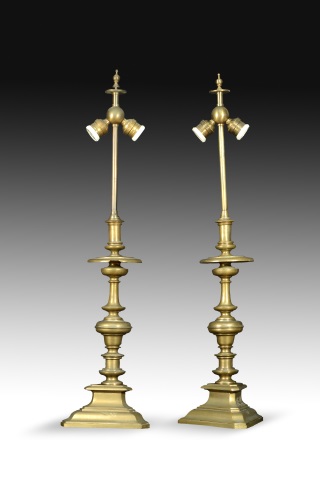
Pair of Dutch-style candlesticks. 18th century Bronze. Electrified like lamps. Pair of Dutch-style candlesticks converted into lamp bases. They feature a turned structure, typical of the refined Baroque style.
· Size: 55x55x79 cms.
ANTIQUES
MISCELLANEUS;OTHER OBJECTS
Ref.: Z6491
-
Peace-bearer. Bronze. 16th century. A peace-bearer made of bronze with a flat handle curved on the back, with a relief decoration on the front organised in an architectural composition with a classical influence, common in the Renaissance. Below the columns on the sides there are two heraldic shields (without a bonnet, cords with tassels on three levels) with a Latin cross in the middle area; the centre shows a Birth of Christ under a domed cupola with winged angel heads in the corners; at the top and under a semicircular arch, there is the bust of Saint Dominic of the Causeway, facing forward, with an inscription in capital letters (“STO /DOMI”, “BENEDITUS SER”) flanked by two perched birds.
· Size: 10,5x4x16 cms.
ANTIQUES
MISCELLANEUS;OTHER OBJECTS
Ref.: ZF0543B
-
Lectern. Wrought iron. Baluster 17th century; rest 20th century. A wrought iron lectern with three twisted S-shaped legs with a disc in the centre, a balustraded base with different sections and a top with straight stripes. This central axis consists of different sections (solomonic and balustraded, joined by a piece of discs and other mouldings), and its lines are characteristic of ironwork of the period (compare, for example, with the Choir Grille of the Cathedral of Valladolid, currently in the Metropolitan Museum of New York, and note its differences). Weight: 22 kg.
· Size: 42x48x155 cms.
ANTIQUES
MISCELLANEUS;OTHER OBJECTS
Ref.: ZF0581
-
Spice rack. Silver. Spain, Cordoba, second half of the 18th century. With contrast marks. Silver spice rack in its colour with a truncated cone-shaped body, a sinuous lower edge resting on legs with scrolls and plant motifs, a semi-spherical bowl without divisions, a lid with a dome-shaped hinge and decorated with plant elements in high relief. The lid features a rose surrounded by a line of dots that create waves. The hallmarks place the piece's production in Córdoba, verified by Damián de Castro and by the hand of Juan Sánchez Soto (probably Cristóbal's son and brother), in the second half of the 18th century. Typologically, this is a spice rack belonging to a somewhat peculiar tradition or model, common in Córdoba and Madrid but also present in Gerona, Antequera, etc. Weight: 87 grams.
· Size: 7,5x6x5 cms
ANTIQUES
MISCELLANEUS;SILVER
Ref.: ZF0982
-
Spice rack. Silver. Cordoba, 18th century. With contrast marks. Silver spice rack in its colour with a truncated cone-shaped body, a sinuous lower edge resting on volute legs with osier and floral motifs, a hemispherical bowl, a lid with a dome-shaped hinge, and decorated with plant elements in high relief. The hallmarks it presents identify it as an 18th century Cordoban work, by the hand of Juan de Luque y Leyva or Leiva (1721-1779/80), who was an official marker of the city between 1772 and 1779/80. Typologically, it is a spice rack belonging to a somewhat peculiar tradition or model, frequent in Cordoba and Madrid but also present in Gerona, Antequera, etc. Weight: 68 grams.
· Size: 7x7x4,5 cms
ANTIQUES
MISCELLANEUS;SILVER
Ref.: ZF0983